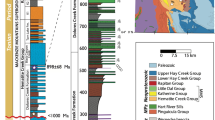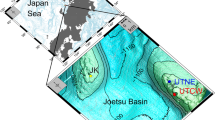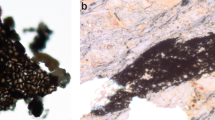Abstract
Despite many investigations concerning the insoluble organic matter in sediments (kerogen), its chemical nature and origin are only poorly understood. Here we report the results of a combined microscopy and chemical study of the Messel Oil Shale which shed light on the mechanism of kerogen formation. Scanning electron microscopy revealed the overwhelming presence of cell-wall remains of Tetraedron-like microalgae which are virtually indistinguishable from those of the widely occurring extant Tetraedron minimum (Chlorococcales). Flash-pyrolysis gas chromatography/mass spectroscopy indicated the presence of an insoluble, non-hydrolysable highly aliphatic biopolymer in both fossil and extant Tetraedron species. The bulk of the Messel Oil Shale kerogen probably consists of selectively preserved cell-wall material of Tetraedron algae, mainly made up of this newly discovered biopolymer. We therefore suggest that this polymer, and similar types of recently discovered highly aliphatic biopolymers in other algae and plant cuticles, are important precursors of n-alkanes in crude oils.
This is a preview of subscription content, access via your institution
Access options
Subscribe to this journal
Receive 51 print issues and online access
$199.00 per year
only $3.90 per issue
Buy this article
- Purchase on Springer Link
- Instant access to full article PDF
Prices may be subject to local taxes which are calculated during checkout
Similar content being viewed by others
References
Tobien, H. Notizbl. hess. Landesamt. Bodenforsch. 96, 111–119 (1968).
Von Koenigswald, W. & Michaelis, W. Geol. Jb. Hessen 112, 5–26 (1984).
Irion, G. Natur Mus., Frankf. 107, 213–218 (1977).
Goth, K. Cour. Forsch.-Inst. Senckenberg 85, 209–211 (1986).
Hayes, J. M., Takigiku, R., Ocampo, R., Callot, H. J. & Albrecht, P. Nature 329, 48–51 (1987).
Püttmann, W. & Goth, K. Cour. Forsch.-Inst. Senckenberg 102 (in the press).
Kováčik, L. Arch. Hydrobiol. Suppl. 46, 354–391 (1975).
Komárek, J. & Fott, B. Das Phytoplankton des Süβwassers, 7.Teil, 1. Hälfte, Chlorophyceae (Grünalgen) Ordnung: Chlorococcales 695–700 (Schweizerbart, Stuttgart, 1983).
Kováčik, L. & Kalina, T. Arch. Hydrobiol. Suppl. 46, 433–444 (1975).
Ourisson, G., Mattern, G. & Albrecht, P. J. chem. Soc. D 22, 1570–1571 (1970).
Nip, M., Tegelaar, E. W., de Leeuw, J. W., Schenck, P. A. & Holloway, P. J. Naturwissenschaften 73, 579–585 (1986).
Nip, M. et al. in Advanced Organic Geochemistry 1985 (eds Leythaeuser, D. & Rullkötter, J.) 769–778 (Pergamon, Oxford, 1986).
Nip, M. et al. Geochim. cosmochim. Acta (in the press).
Largeau, C., Derenne, S., Casadevall, E., Kadouri, A. & Sellier, N. in Advanced Organic Geochemistry 1985 (eds Leythaeuser, D. & Rullkötter, J.) 1023–1032 (Pergamon, Oxford, 1986).
Derenne, S., Largeau, C., Casadevall, E., Tegelaar, E. W. & de Leeuw, J. W. Fuel Process. Tech. (in the press).
Chappe, B., Albrecht, P. & Michaelis, W. Science 217, 65–66 (1982).
Philp, R. P. & Calvin, M. Advanced Organic Geochemistry 1975 (eds Campos, R. & Goni, J.) 735–752 (Enadisma, Madrid, 1976).
Philp, R. P. & Calvin, M. Nature 262, 134–136 (1976).
Van de Meent, D., Brown, S. C., Philp, R. P. & Simoneit, B. R. T. Geochim. cosmochim. Acta 44, 999–1013 (1980).
Tissot, B. P. & Welte, D. H. Petroleum Formation and Occurrence. (Springer, Berlin, 1984).
Kerogen—Insoluble Organic Matter from Sedimentary Rocks (ed. Durand, B.) (Technip, Paris, 1980).
Holloway, P. J. in CRC Handbook of Chromatography, Lipids Vol. 1 (ed. Mangold, H. K.) 321–334 (CRC, Boca Ranton, 1984).
Holloway, P. J. in CRC Handbook of Chromatography, Lipids Vol. 1 (ed. Mangold, H. K.) 347–380 (CRC, Boca Ranton, 1984).
Tegelaar, E. W. et al. J. anal. appl. Pyrolysis (in the press).
Goossens, H., de Leeuw, J. W., Schenck, P. A. & Brassell, S. C. Nature 312, 440–442 (1984).
Van de Meent, D., de Leeuw, J. W. & Schenck, P. A. Adv. org. Geochem. 1979 (eds Douglas, A. G. & Maxwell, J. R.) 469–474 (Pergamon, Oxford, 1980).
Author information
Authors and Affiliations
Rights and permissions
About this article
Cite this article
Goth, K., de Leeuw, J., Püttmann, W. et al. Origin of Messel Oil Shale kerogen. Nature 336, 759–761 (1988). https://doi.org/10.1038/336759a0
Received:
Accepted:
Issue Date:
DOI: https://doi.org/10.1038/336759a0
This article is cited by
-
Structural assessments of kerogen-rich oil shale from the Central Kongo formation by solid-state 13C nuclear magnetic resonance and thermal processes
Journal of Thermal Analysis and Calorimetry (2022)
-
Microalgae disruption techniques for product recovery: influence of cell wall composition
Journal of Applied Phycology (2019)
-
Microfossils and molecular records in oil shales of the Songliao Basin and implications for paleo-depositional environment
Science in China Series D: Earth Sciences (2009)
-
Biomacromolecules of Algae and Plants and their Fossil Analogues
Plant Ecology (2006)
-
Lacustrine biomass: An significant precursor of high wax oil
Chinese Science Bulletin (2003)
Comments
By submitting a comment you agree to abide by our Terms and Community Guidelines. If you find something abusive or that does not comply with our terms or guidelines please flag it as inappropriate.



